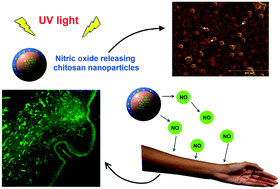Abstract
The use of nanoparticle-based transdermal delivery systems is a promising approach to efficiently carry and deliver therapeutic agents for dermal and systemic administration. Nitric oxide (NO) is a key molecule that plays important roles in human skin such as the control of skin homeostasis, skin defense, control of dermal blood flow, and wound healing. In addition, human skin contains stores of NO derivatives that can be mobilized and release free NO upon UV irradiation with beneficial cardiovascular effects, for instance the control of blood pressure. In this work, the NO donor precursor glutathione (GSH) was encapsulated (encapsulation efficiency of 99.60%) into ultra-small chitosan nanoparticles (CS NPs) (hydrodynamic size of 30.65 ± 11.90 nm). GSH-CS NPs have a core-shell structure, as revealed by atomic force microscopy and X-ray photoelectron spectroscopy, in which GSH is protected in the nanoparticle core. Nitrosation of GSH by nitrous acid led to the formation of the NO donor S-nitrosogluthathione (GSNO) into CS NPs. The GSNO release from the CS NPs followed a Fickian diffusion described by the Higuchi mathematical model. Topical application of GSNO-CS NPs in intact human skin significantly increased the levels of NO and its derivatives in the epidermis, as assayed by confocal microscopy, and this effect was further enhanced by skin irradiation with UV light. Therefore, NO-releasing CS NPs are suitable materials for transdermal NO delivery to local and/or systemic therapies.


 Please wait while we load your content...
Please wait while we load your content...